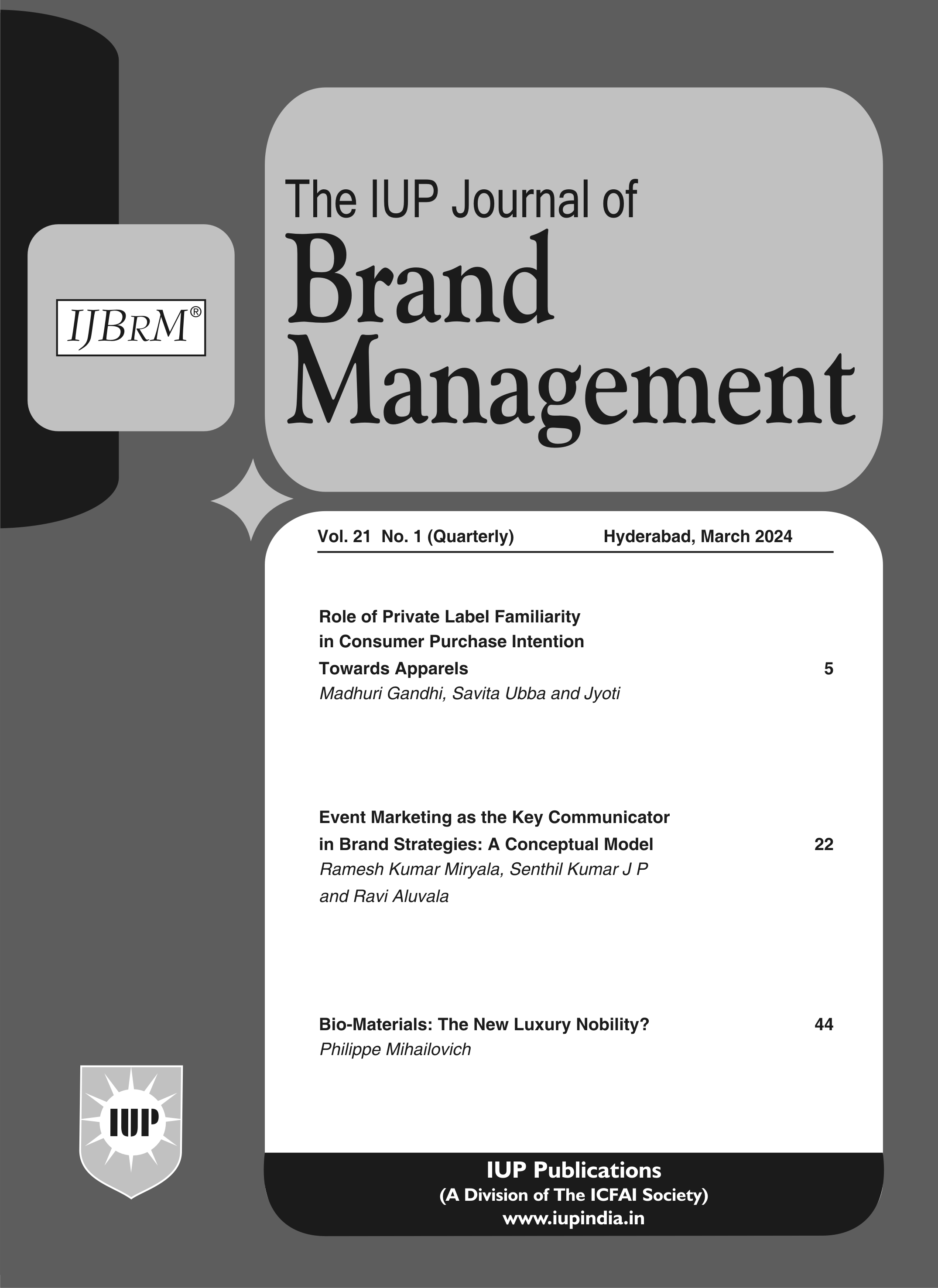
Jun'19
The IUP Journal of Brand Management
Focus
This issue consists of two papers and a case study. The first paper, �Factors
Affecting Brand Image: The Case of Pepsodent in Da Nang, Vietnam�, by Trinh
Le Tan and Dao Thi Dai Trang, pertains to the brand image of the well-known toothpaste brand Pepsodent in Da Nang, Vietnam. The study explores the impact of customer attitude, brand familiarity, brand awareness and brand extensions on the brand image of Pepsodent. The methodology used is regression analysis, based on feedback from 200 respondents. It is found that all the four variables have positive and significant impact on parent brand image. Brand familiarity, followed by brand awareness and brand extensions, has the maximum impact, thereby suggesting that marketers have to focus more on these parameters in order to build a strong and positive brand image.
The second paper, �The Impact of Tourists� Sociodemographic Characteristics on Perceived Destination Image�, by Sabari Shankar R, also pertains to brand image; but this time, the brand image of a tourist destination. The paper examines the influence of sociodemographic characteristics of tourists on perceived destination image, both cognitive and affective. The destination selected for the study is Coimbatore city in south India and the analysis is based on responses from 448 visitors to the city. The study examines the impact of sociodemographic characteristics of tourists on several cognitive and affective image parameters. It is found that age, education, occupation and income significantly influence perceived destination image. As an aside, the study also throws light on how tourists perceive Coimbatore on various parameters.
The last is a case study, �Coca-Cola�s Shift to �One Brand� Strategy: Can It Change Consumers� Perception?�, by Syeda Maseeha Qumer and Debapratim Purkayastha, too pertains to consumer perception of a brand. It covers the topic of Coca-Cola�s �One Brand� strategy (as against the marketing focus on sub-brands) in the US; how this was executed; and the reactions that it received. This makes an interesting case study on marketing campaign and its influence on the target market.
Consulting Editor
Factors Affecting Brand Image: The Case of Pepsodent in Da Nang, Vietnam
The purpose of the study is to explore the influence of brand extension, brand awareness, brand familiarity and customer attitude on brand image with regard to the famous toothpaste brand, Pepsodent, in Vietnam. These variables are very important aspects of building a strong brand and in increasing the profitability in the competitive market and/or upturn efficiency through reducing marketing costs. For this study, a 5-point Likert scale questionnaire, consisting of 22 items, divided into five parts, was designed. A total of 200 questionnaires were distributed purposively conveniently in Da Nang, one of the large cities in Vietnam, and the response rate was 100%. The findings show that the variables brand extension, brand awareness, brand familiarity and customer attitude contribute to the parent image after extension.
The Impact of Tourists� Sociodemographic Characteristics on Perceived Destination Image
The Indian economy is expected to be the third largest by 2028. This sets the pace for various sectors, including the tourism sector. It is highly important to understand the existing tourists� behavior and perception towards destinations. The paper understands the impact of tourists� sociodemographic characteristics on perceived destination image, both cognitive and affective. This work has been extracted from a major research work on destination image with Coimbatore as the tourist destination. Data was collected through a structured questionnaire from 448 tourists and SPSS has been used for analyzing the data. Interpretation has been made based on multivariate analysis. The major findings are that sociodemographic characteristics such as age, education, occupation and income of tourists significantly influence perceived destination image. The most important image aspects of the destination have been examined and listed for the purpose of informing the destination marketers during strategic planning on branding the destination.
Coca-Cola�s Shift to �One Brand� Strategy: Can It Change Consumers� Perception?
The case discusses global beverage giant The Coca-Cola Company�s (TCC) new �One Brand� global marketing strategy that, for the first time ever, united Coca-Cola, Diet Coke, Coca-Cola Zero, and Coca-Cola Life under the iconic Coca-Cola master brand as part of one global creative campaign, �Taste the Feeling.� The overhaul was the result of the sales volumes of Coke continuing to drop because of consumers cutting back on carbonated drinks due to health concerns. The revamped marketing strategy aimed to accelerate the sales of low calorie drinks and eliminate the brand confusion within the Coke portfolio that had in part been caused by the brand�s earlier attempts to adapt to healthier lifestyles. Under the new strategy, TCC replaced its long running brand-focused �Open Happiness� campaign with a new campaign �Taste the Feeling� wherein the product, rather than the brand, took center stage. Going forward, the newly appointed �Chief Growth Officer� (CGO) of TCC, Francisco Crespo, faced a multitude of challenges including slumping carbonated beverages sales, intense competition, dramatic shifts in consumer habits, and imposition of sugar tax on soft drinks by several regulators globally. Can the �One Brand� strategy boost sales while strengthening the overall Coke brand? Can it shift consumer metrics in the right direction and change consumer perceptions of the brand?